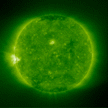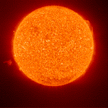 A new look at the Sun --- This image taken by the Extreme ultraviolet Imaging
Telescope (EIT) on board the Solar and Heliospheric Observatory (SOHO)
spacecraft on 1996 May 6 at 14:54 UT shows solar coronal plasma at temperatures
of 800,000 to 1,000,000 K. An emerging active region is visible north of disk
center, and a larger, older region is rotating onto the disk from the East
(left) limb of the Sun. Faint plumes at the poles of the Sun carry material
outward into the solar wind in high-speed streams. The poles appear dark
because they are the sites of apparently permanent "coronal holes," areas of
open magnetic field and depressed density and maximum temperature. SOHO is a
joint ESA-NASA mission of international cooperation. (Credit: The EIT
Consortium)
A new look at the Sun --- This image taken by the Extreme ultraviolet Imaging
Telescope (EIT) on board the Solar and Heliospheric Observatory (SOHO)
spacecraft on 1996 May 6 at 14:54 UT shows solar coronal plasma at temperatures
of 800,000 to 1,000,000 K. An emerging active region is visible north of disk
center, and a larger, older region is rotating onto the disk from the East
(left) limb of the Sun. Faint plumes at the poles of the Sun carry material
outward into the solar wind in high-speed streams. The poles appear dark
because they are the sites of apparently permanent "coronal holes," areas of
open magnetic field and depressed density and maximum temperature. SOHO is a
joint ESA-NASA mission of international cooperation. (Credit: The EIT
Consortium)
 A new look at the Sun --- This image taken by the Extreme ultraviolet Imaging
Telescope (EIT) on board the Solar and Heliospheric Observatory (SOHO)
spacecraft on 1996 May 6 at 19:34 UT shows solar coronal plasma at temperatures
of 1,500,000 K. An emerging active region is visible north of disk
center, and a larger, older region is rotating onto the disk from the East
(left) limb of the Sun. Faint plumes at the poles of the Sun carry material
outward into the solar wind in high-speed streams. The poles appear dark
because they are the sites of apparently permanent "coronal holes," areas of
open magnetic field and depressed density and maximum temperature. "Bright
points," magnetic loop systems smaller and shorter-lived than active regions,
are visible both in the polar holes and elsewhere on the disk. SOHO is a joint
ESA-NASA mission of international cooperation. (Credit: The EIT Consortium)
A new look at the Sun --- This image taken by the Extreme ultraviolet Imaging
Telescope (EIT) on board the Solar and Heliospheric Observatory (SOHO)
spacecraft on 1996 May 6 at 19:34 UT shows solar coronal plasma at temperatures
of 1,500,000 K. An emerging active region is visible north of disk
center, and a larger, older region is rotating onto the disk from the East
(left) limb of the Sun. Faint plumes at the poles of the Sun carry material
outward into the solar wind in high-speed streams. The poles appear dark
because they are the sites of apparently permanent "coronal holes," areas of
open magnetic field and depressed density and maximum temperature. "Bright
points," magnetic loop systems smaller and shorter-lived than active regions,
are visible both in the polar holes and elsewhere on the disk. SOHO is a joint
ESA-NASA mission of international cooperation. (Credit: The EIT Consortium)
 A newish look at the Sun --- This image taken by the Extreme ultraviolet
Imaging Telescope (EIT) on board the Solar and Heliospheric Observatory (SOHO)
spacecraft on 1996 February 11 at 21:50 UT shows solar transition region
plasma at temperatures of 60,000 K. An eruptive prominence has been ejected
from the southeast (lower left) limb of the Sun at a speed of over 30 km/s.
A somewhat less active prominence is visible on the northwest limb (upper
right). "Spicules," small jets of cooler matter extending into
the corona, can be seen around the limb, while a few larger "macrospicules"
are visible at in the polar coronal holes. The chromospheric networ of
"supergranular" cells covers the disk, and a small coronal hole is seen in the
northeast (upper left) quadrant of the Sun's surface.
loop systems smaller and shorter-lived than active regions, are visible both
in the polar holes and elsewhere on the disk. SOHO is a joint ESA-NASA mission
of international cooperation. (Credit: The EIT Consortium)
A newish look at the Sun --- This image taken by the Extreme ultraviolet
Imaging Telescope (EIT) on board the Solar and Heliospheric Observatory (SOHO)
spacecraft on 1996 February 11 at 21:50 UT shows solar transition region
plasma at temperatures of 60,000 K. An eruptive prominence has been ejected
from the southeast (lower left) limb of the Sun at a speed of over 30 km/s.
A somewhat less active prominence is visible on the northwest limb (upper
right). "Spicules," small jets of cooler matter extending into
the corona, can be seen around the limb, while a few larger "macrospicules"
are visible at in the polar coronal holes. The chromospheric networ of
"supergranular" cells covers the disk, and a small coronal hole is seen in the
northeast (upper left) quadrant of the Sun's surface.
loop systems smaller and shorter-lived than active regions, are visible both
in the polar holes and elsewhere on the disk. SOHO is a joint ESA-NASA mission
of international cooperation. (Credit: The EIT Consortium)
 For much more
information on the SOHO mission, try the
SOHO home page.
For much more
information on the SOHO mission, try the
SOHO home page.
![]() For the
latest images from SOHO and other space and ground-based
observatories, try the SDAC
current solar
images page.
For the
latest images from SOHO and other space and ground-based
observatories, try the SDAC
current solar
images page.